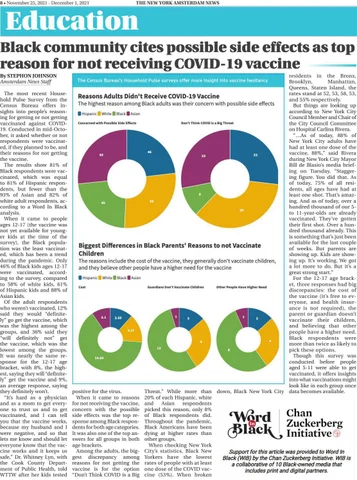8 • November 25, 2021 - December 1, 2021
THE NEW YORK AMSTERDAM NEWS
Education Black community cites possible side effects as top reason for not receiving COVID-19 vaccine By STEPHON JOHNSON Amsterdam News Staff The most recent Household Pulse Survey from the Census Bureau offers insights into people’s reasoning for getting or not getting vaccinated against COVID19. Conducted in mid-October, it asked whether or not respondents were vaccinated, if they planned to be, and their reasons for not getting the vaccine. The results show 81% of Black respondents were vaccinated, which was equal to 81% of Hispanic respondents, but fewer than the 93% of Asian and 82% of white adult respondents, according to a Word In Black analysis. When it came to people ages 12-17 (the vaccine was not yet available for younger kids at the time of the survey), the Black population was the least vaccinated, which has been a trend during the pandemic. Only 46% of Black kids ages 12-17 were vaccinated, according to the survey, compared to 58% of white kids, 61% of Hispanic kids and 88% of Asian kids. Of the adult respondents who weren’t vaccinated, 12% said they would “definitely” go get the vaccine, which was the highest among the groups, and 36% said they “will definitely not” get the vaccine, which was the lowest among the groups. It was nearly the same response for the 12-17 age bracket, with 8%, the highest, saying they will “definitely” get the vaccine and 9%, an average response, saying they definitely won’t. “It’s hard as a physician and as a mom to get everyone to trust us and to get vaccinated, and I can tell you that the vaccine works, because my husband and I were negative, and so that lets me know and should let everyone know that the vaccine works and it keeps us safe,” Dr. Whitney Lyn, with the Cook County Department of Public Health, told WTTW after her kids tested
residents in the Bronx, Brooklyn, Manhattan, Queens, Staten Island, the rates stand at 52, 53, 58, 53, and 55% respectively. But things are looking up according to New York City Council Member and Chair of the City Council Committee on Hospital Carlina Rivera. “…As of today, 88% of New York City adults have had at least one dose of the vaccine, 88%,” said Rivera during New York City Mayor Bill de Blasio’s media briefing on Tuesday. “Staggering figure. You did that. As of today, 75% of all residents, all ages have had at least one shot. That’s amazing. And as of today, over a hundred thousand of our 5to 11-year-olds are already vaccinated. They’ve gotten their first shot. Over a hundred thousand already. This is something that’s just been available for the last couple of weeks. But parents are showing up. Kids are showing up. It’s working. We got a lot more to do. But it’s a great strong start.” For the 12-17 age bracket, three responses had big discrepancies: the cost of the vaccine (it’s free to everyone, and health insurance is not required), the parent or guardian doesn’t vaccinate their children, and believing that other people have a higher need. Black respondents were more than twice as likely to pick these options. Though this survey was conducted before people aged 5-11 were able to get vaccinated, it offers insights into what vaccinations might look like in each group once down, Black New York City data becomes available.
The Census Bureau’s Household Pulse surveys offer more insight into vaccine hesitancy
positive for the virus. When it came to reasons for not receiving the vaccine, concern with the possible side effects was the top response among Black respondents for both age categories. It was also one of the top answers for all groups in both age brackets. Among the adults, the biggest discrepancy among reasons for not getting the vaccine is for the option “Don’t Think COVID is a Big
Threat.” While more than 20% of each Hispanic, white and Asian respondents picked this reason, only 8% of Black respondents did. Throughout the pandemic, Black Americans have been dying at higher rates than other groups. When checking New York City’s statistics, Black New Yorkers have the lowest rates of people with at least one dose of the COVID vaccine (53%). When broken












